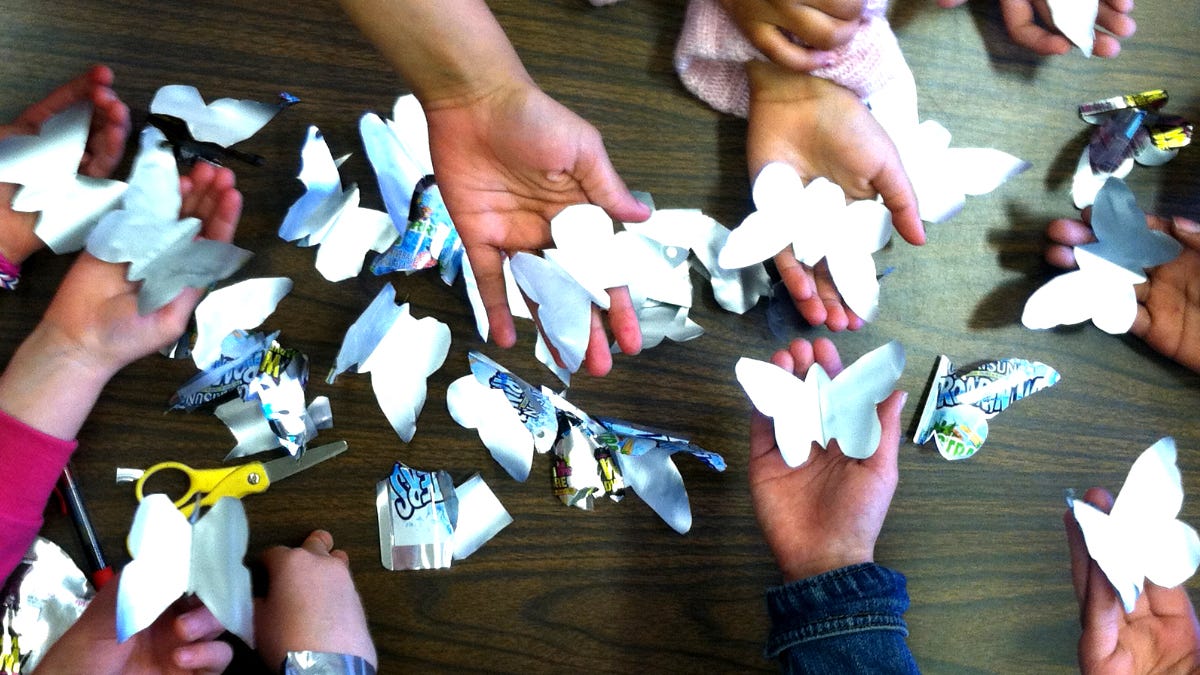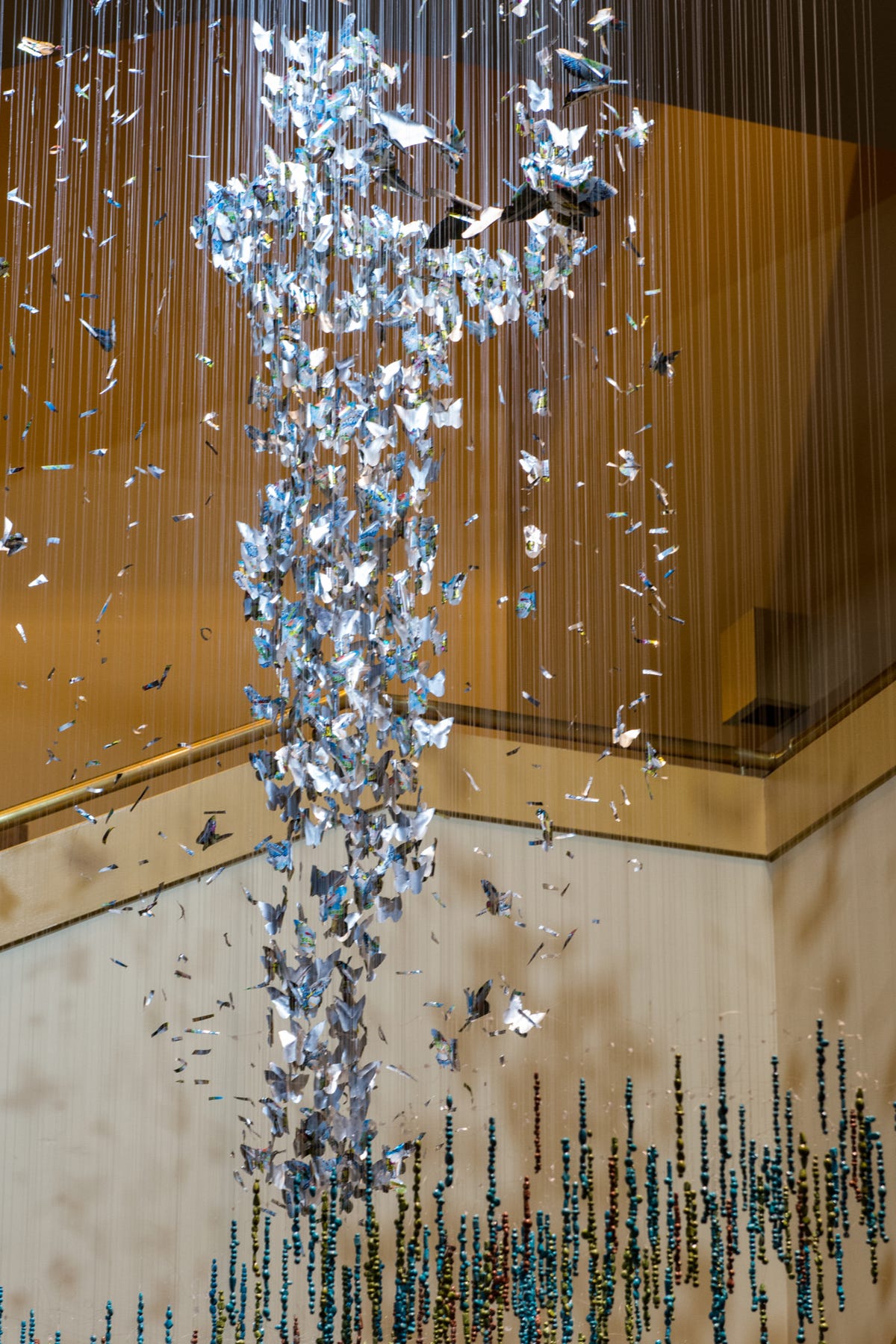Emerging from Chrysalides: The Butterfly Effect (Offering 8.1)
Transformation, courage, and the quiet power of small choices.
The metamorphosis continues in a new phase—Emerging from Chrysalides. This chapter returns to one of my favorite public artworks, The Butterfly Effect, a project that transformed not only a community—but me.
(If you’re new to Eclosion: An Artist’s Path to Power and Peace, start at the beginning. Or visit my Memoir Hub for a full table of contents with links.)
The Butterfly Effect
When I faced my fear of completing Rise Above Plastics: The Butterfly Effect, I succeeded in so many ways. It wasn’t easy, and I really did almost fail while installing the piece.
The installation schedule was tight—we had only a single night and day to install the piece in the atrium of The Washington Center for the Performing Arts.
I prepped hundreds of pieces of monofilament to attach the butterflies to. Volunteers, including some good friends, came out to help me string all those lines. Each string needed to be tied to the frame above, then tied to a string of beads below. Shon, always helpful with engineering my pieces, had come up with an idea we hoped would speed up the process—tying a loop at the bottom of each string in advance. The loops would make it easier to attach the strands of beads that we’d made to act as stabilizers.
We worked for hours, tying the strings onto the frame, but the loops at the bottoms kept getting tangled. There were just so many of them. And they kept getting more and more tangled as it got later and later. At one point, I looked over at a dear friend. She was sitting on the floor, after hours of tying and untangling, with a snarled wad of monofilament in her lap. She looked at me, almost with tears in her eyes and said, “Carrie, I don’t think we’re going to be able to do it!”
I took a deep breath, called everyone to a halt, thanked them for their help, and sent them home. Then I went around and cut all the tangles and knots off, trusting that I would find a new way to attach the stabilizers—trusting because I had to, or maybe calling on my stubbornness and unwillingness to give up. Ultimately, it worked out. With the loops cut off, we untangled the lines and tied the stabilizing beads to the bottom, completing a hanging art installation that captivated those who saw it—even me.
Witnessing people’s reactions to The Butterfly Effect installation was mind opening. Let me see if I can paint you a picture.
Imagine yourself in the atrium of a four-story theatre. From below, beside, and above, you witness hundreds upon hundreds of gently spinning butterflies, suspended in midair. As they slowly turn, they reflect the lights in sparkling patterns. You are spellbound—held by the quiet beauty. But somehow, you are still on the surface. What exactly are you seeing? Is it simply a kaleidoscope of butterflies—beautiful and mesmerizing in and of itself?
You look closer and longer, maybe just a few seconds, maybe minutes. Maybe you leave and return again before you see more. But eventually, eventually you see that the butterflies, all together, create the image of a person standing inside of a butterfly chrysalis. That figure, formed by spinning butterflies and air, is pulling their chrysalis open, ready to step out anew, with butterflies of change flying from their heart.
When people witnessed this imagery, they were astounded by the beauty. Once they saw it, they could no longer unsee it.
But then, then those same witnesses learned that every single butterfly was made by a different person, many of them by a different child. They learned that each butterfly was made from, of all things, a disposable, plastic juice pouch. They learned that this massive, intricate art piece was created by over 700 different individuals exploring the power of their own personal choices.
And their hearts and their minds were transformed. Maybe only for that moment or for that day. Maybe they were transformed in a way that they could never go back, never unsee what they had seen.
This is what collaborative art can do for us. It gives us the means to open hearts, to break down barriers, to see things in a way we never saw them before. It creates a way to reach people on an emotional—maybe even spiritual—level.
That is where change happens.
The Butterfly Effect is now permanently installed at the Thurston County Family and Juvenile Court building, a place where the idea of the power of our personal choices resonates on an entirely new level. A friend once shared an experience she had at the courthouse while finalizing her divorce. She was sitting, foot tapping anxiously, waiting to be called inside, looking around for something to distract herself. When she her eyes fell on the butterflies, her foot stilled and calm washed over her. She no longer felt alone in that difficult time.
To this day, it remains one of my favorite pieces, not only for its beauty and the deep significance of the Butterfly Effect, but for the inner story it holds. Completing a project about transformation while undergoing my own profound transformation through recovery from alcoholism created a deeply personal link to the project’s symbolism. From that point on, I began incorporating butterflies into each of my public art pieces, with butterflies and chrysalides becoming prominent in my studio work.
I visit this installation every few years. With each visit I feel the emotions of that time rise within me. I see now how I was in my own chrysalis during that time—my entire way of being breaking down as I was remade into something new.
The Butterfly Effect was born from my own metamorphosis, even as it was grounded in community. Every workshop, every thread of monofilament, every butterfly, was a small act of faith—a tangible expression of the courage it takes to transform. In that process, I began to understand fear differently.
We are all afraid. Fear underlies so much of who we are and is a natural part of being human. Our fear is trying to protect us. For many of us, the things we are afraid of come from old stories, old trauma. As we grow, it is a powerful act to shed the old stories that no longer serve us—those stories that now hold us back. The only way I know to deal with my fear is to acknowledge it, maybe even welcome it in. But I no longer allow it to hold me back. I walk through fear with as much gentleness, love, and grace as I can, surrounded by a supportive community.
It was through facing my fears with The Butterfly Effect—from starting the project, staying with it even when it was tough, through completion—that gave me the confidence and courage to leave my day job and pursue art full time in 2014.
In the following ten years I would work with thousands of individuals and organizations, with local governments and tribes, making collaborative art around environmental and social justice issues. Throughout all of this, I continued to learn and grow, to fall and get back up, and then grow some more. I would not have become the successful artist I am today without facing my fears, getting sober, and doing the hard, ongoing self-work that made possible a version of myself I never knew could exist.
Think of a time when things became tangled or uncertain in your own life or work. What helped you stay with it—and what transformation came through staying the course?


